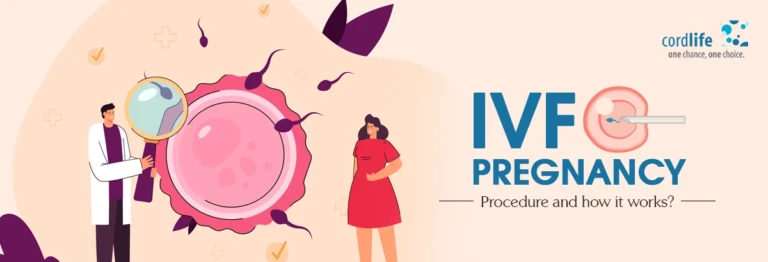Pregnancy is a team effort. A couple may have been planning a pregnancy for some time but have been unsuccessful. Reasons can be genetic or lifestyle, age and medical disorders.
Genetic or lifestyle disorders can be corrected naturally – perhaps with good nutrition, doing the right kind of exercise and meditation, or sometimes with medical help. As for age, there’s not much you can do about it. However, medical problems may need to be treated medically.
In the case of medically assisted reproduction, intrauterine insemination (IUI) can be used, as well as assisted reproductive technology.
Besides these scientists like Patrick Steptoe and Robert Edwards reported the first live birth with the help of IVF in July 1978 in England. According to research, with IVF treatment, 1.6% and 4.5% of live births have occurred in places such as Europe, the United States and other countries.
What is IVF treatment for pregnancy?
In natural conception, the egg and sperm come together to be fertilized. An egg is released from the ovaries in a menstrual cycle and then travels to the fallopian tubes. Sperm also penetrate through the vagina, cervix and uterus, and finally into the fallopian tube, fertilizing the eggs. Fertilized eggs gradually move towards the uterus and attach to the lining of the uterus.
In vitro fertilization (IVF) on the other hand, it is an assisted reproductive technology (ART). “In vitro” comes from the Latin phrase “in glass”. Thus, during the process of in vitro fertilization (IVF), eggs are removed from the woman’s ovary and join with sperm outside the body to form embryos. Fertilization is done under controlled conditions in a laboratory dish. The embryo then grows in the lab for several days and eventually attaches to the uterus.
Why is IVF treatment needed?
Most of the time infertility problems start with ovulation problems. Irregular menstruation or the absence of menstruation does not allow the eggs to be fertilized. Irregular periods occur due to polycystic ovary syndrome (PCOS). Polycystic ovary syndrome (PCOS) is a hormonal imbalance – which can interfere with normal ovulation.
In addition to this, pelvic inflammatory disease or surgery for an ectopic pregnancy can cause a blocked fallopian tube. and uterine problems or fibroids are some of the reasons behind fertility problems in women.
Additionally, being overweight or underweight, stress, poor diet as well as age can be some of the key factors behind a woman’s ability to give birth.
Regarding age, 20% of women can give birth after 35 years. Otherwise, age can be one of the biggest problems in a third of couples. With age, a woman’s ovaries can release fewer eggs and unhealthy eggs.
But a woman alone cannot bear the burden of inability to bear children, a man is equally responsible for it. Thus, the health professional can check sexual problems, low sperm count and sperm movement in men.
What is IVF?
So a couple trying to have a baby willing to undergo IVF treatment will have some pre-IVF tests, including a wide range of blood tests to look at hormonal fluctuations, check ovarian reserve and look at overall reproductive health. health.
With this, sperm evaluation is done in men – to check the shape, number, concentration and motility of the sperm.
Once these tests are completed, the IVF process takes two or more weeks to complete. All these steps together form the IVF cycle. These steps include:
Stimulation of Ovaries
Normally, an ovary releases an egg during a menstrual cycle. However, in IVF treatment, fertility drugs are given to increase the number of eggs. Such drugs include follicle-stimulating hormone (FSH), human menopausal gonadotropin (hMG), or both. These drugs help the eggs to mature in the ovaries. Before the eggs are collected and fertilized in the laboratory, they must first mature in the ovaries. Once the eggs are mature, human chorionic gonadotropin (hCG) and GnRH agonist drugs stimulate the ovaries to produce eggs. The eggs must eventually be retrieved.
Egg retrieval
It takes about 36 hours to stimulate the ovaries and uses follicular aspiration to retrieve the eggs from the ovaries. During this time, a transvaginal ultrasound is performed. The healthcare provider puts a needle through the vagina, into the ovaries, and removes the eggs from the follicle that way. Egg retrieval takes 15 to 30 minutes.
Fertilization
Once the eggs are removed, the sperm from the donor or partner is collected for fertilization in a Petri dish. According to research, 65% to 80% of eggs are fertilized during IVF treatment.
Embryo Culture and Transfer
Once the egg is fertilized, it divides and becomes an embryo. It takes about two to five days to monitor the embryo and its development. In IVF treatment, doctors transfer the embryo fresh and carry out the frozen embryo transfer in the water cycle.
To start the pregnancy, when the new embryo transfer takes place, a progesterone hormone is prescribed to increase the thickness of the lining of the uterus.
Most of the time, only one embryo is transferred. Two or more transfers are less common. It is possible to have twins, triplets or even more children when you carry two or more embryos, although it also increases the chances of pregnancy.
8 to 12 days after the embryo transfer, hCG levels are checked to confirm pregnancy.
Although an expensive procedure, the success rate of IVF is over 85% in autocycle and 99% using donors in all fertility centers across India.
